
On August 1, 1891, Hook and Ladder Company No. 10 on State Street was designated as ready for active service with what was then called the Brooklyn Fire Department. The new company protected the Second District, which was bordered by Johnston Street, Nevins Street, First Place, and Smith Street, and on the west by the waterfront.
According to Our Firemen: The History of the Brooklyn Fire Department, the property in this district of about one square mile represented “more value than that of any other equal portion of the city.” It included all the expensive residential buildings in “The Heights,” a considerable portion of “The Hill,” and all of the large shopping district lying between the Heights and the Hill. Hook and Ladder Company No. 10 responded to calls from 117 boxes on a second alarm, with the most remote box located at the end of Red Hook Point.

Two days after the new company went into service, a new member was added to the roster: a small cat “who wore a fur coat which in color resembled a tortoise shell.”
According to a story in “Our Firemen,” Patsey entered the bay door on August 3, settled into a chair, and, through his general demeanor, indicated that he intended to stay.
The men welcomed him with some warm milk and christened him Patsey. (I have a feeling Patsey was a female cat, as only about 1 in 3,000 tortoiseshell cats are male).
Although Patsey’s name did not appear on the payrolls at Brooklyn’s fire headquarters, the men considered Patsey to be an official fire cat. They even presented him with a silver collar. Life was pretty good for the former street cat, largely due to the all the wonderful features of the new firehouse.
The new firehouse for Hook and Ladder Company No. 10 was quartered in a two-story building at 264 State Street, near Boerum Place. The building was designed by William J. Moran, who also designed a similar looking firehouse in 1890 for Engine Company No. 28 at 436 39th Street (below).

One of the main features of the firehouse was a large gymnasium in the cellar, where the men could work out with rowing machines, dumb bells, heavy and light hammers, Indian clubs, and something called quoits, which was a traditional game that involved the throwing of rings over a set distance. Patsey loved spending time in the gymnasium–his favorite activity was taking lessons in high vaulting and running jumps.
Another favorite activity for Patsey was napping. He loved to sleep on top of the men’s coats on the extreme end of the extension ladder.
One day as he was taking an afternoon nap, an alarm sounded from a box on the corner of Hoyt and Warren Streets. Normally, Patsey was on the alert as soon as the gong sounded, but on this occasion he did not wake up until the truck was on the way to the fire.
At Dean and Pacific Streets, Fireman Collins discovered Patsey with his claws buried deep into one of the coats. He appeared to be completely enjoying the situation!
When the truck arrived at the scene, Patsey was transferred to the driver’s seat and covered up with a coat. He remained on the seat and seemed to enjoy watching the men in action.
Patsey shared the firehouse with the company’s three horses: Larry, Billy, and Dick. The horses were reportedly black, dark brown, and dapple bay. They could get set up and out of the firehouse in just twelve seconds.
Billy, who was nearly seventeen hands high and more than 1,400 pounds, was the veteran, having served for five years with a prior truck company. He was reportedly so well-versed in the telegraph alarm system that no amount of persuasion could encourage him to leave his stall on a “test run.”
I could not find any other articles about Patsey the fire cat, but hopefully she had a good run with her chosen firehouse.
A Brief History of Hook and Ladder Company No. 10
The firehouse for Hook and Ladder Company No. 10 at 264 State Street was built on the former property of Abraham and Peter Schermerhorn.

Abraham and Peter were descendants of Jacob Janse Schermerhorn, a Dutch settler who arrived in New York in 1636. Jacob first settled in Rensselareswyck and reportedly had a home inside the walls of Fort Orange. He and his wife, Jannetie Van Voorhout, were the first in a long line of Schermerhorns of colonial New York.

Abraham and Peter’s parents were Peter Schermerhorn and Elizabeth Bussing. Peter was a commander and owner of shipping vessels trading between New York and Charleston, South Carolina. The brothers entered the family business in 1808.
Following his father’s death in 1826, Abraham inherited 160 acres of land in the Gowanus section of Brooklyn, which his father and uncle had purchased in 1795.
The main residence on this property, built in 1690, was reportedly the oldest house in Brooklyn in 1915, when the photo below was taken. It stood on the site where Brooklyn’s first house was built in 1836; reportedly, some of the original stone walls from that house were used to construct the 1690 house.
The Schermerhorn family lived in Manhattan, but they used their Brooklyn property as a summer residence. Abraham sold the land in January 1835 for $600 an acre. Part of Green-Wood Cemetery was built on the Schermerhorn property.
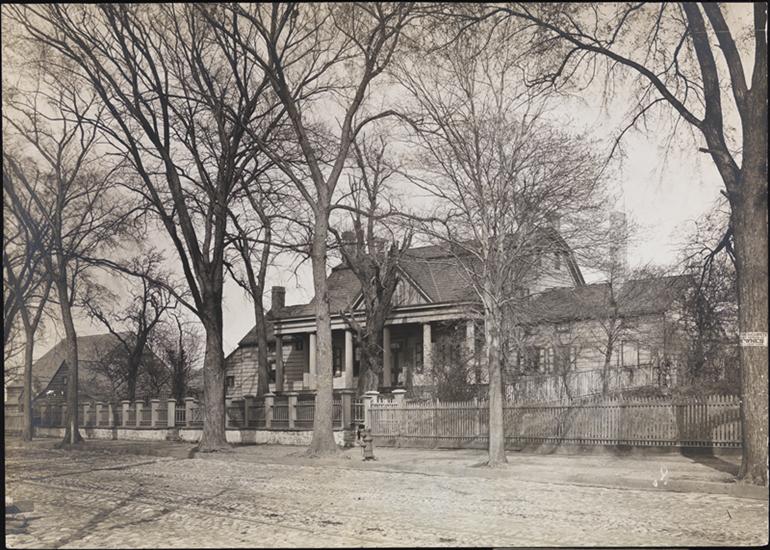
Peter and Abraham Schermerhorn owned a rope factory with what was once the largest ropewalk in the country. The ropewalk was needed to stretch the rope–which were used in shipping and sailing–a long distance.
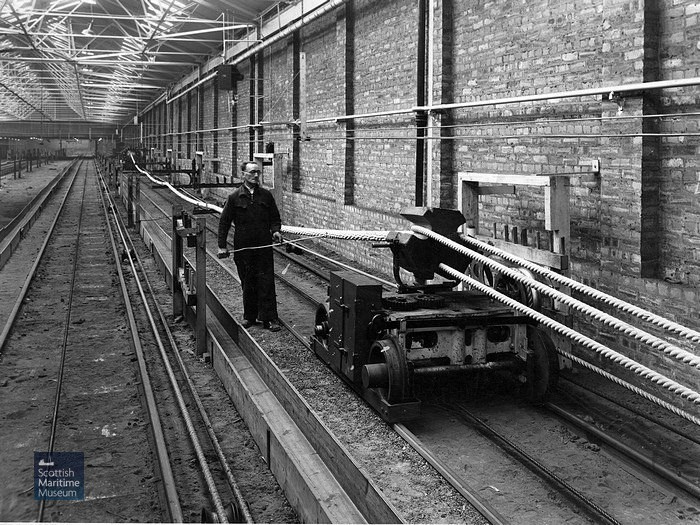
The 1200-long, two-story ropewalk was bounded by Smith and Bond Streets between State Street and what would eventually become Schermerhorn Street.
The ropewalk was destroyed by a fire that started in the stables on December 29, 1841. Sadly, nine horses and a cow were killed in the blaze, and 90 workmen lost their good-paying jobs. Following the fire, new buildings were erected which were “more in keeping with the neighborhood.”
One of the more interesting developments along Schermerhorn and State Streets was Mr. Edward L. Graeff’s gardens and greenhouses, as noted on the 1855 map below.
Graeff, a German horticulturalist and associate of the Natural History Department of the Brooklyn Institute, established the garden in 1851. The greenhouses featured “a choice selection of horticultural history,” including hyacinths, rhododendron, geraniums, roses, and much more.

Directly across the street from Mr. Graeff’s gardens was a brick store at what would become 264 State Street. Sometime between 1855 and 1880, the store was demolished.
On June 20, 1890, the City of Brooklyn purchased the vacant property at 264 State Street from John Adamson and his wife. The city paid $6,000 for the property. One year later, the men, horses, and cat of Hook and Ladder Company No. 10 moved into their new firehouse.
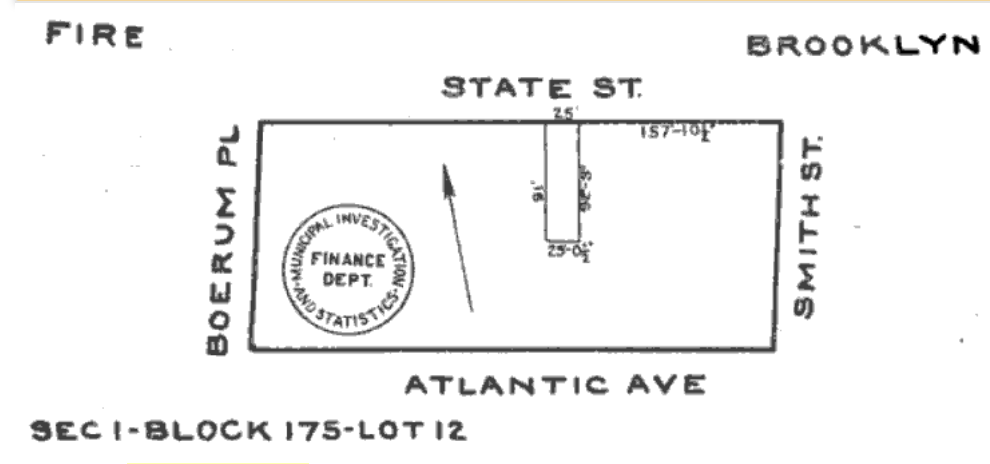
In 1898, Hook and Ladder Company 10 of the Brooklyn Fire Department became Ladder Company 10 of the Fire Department of New York.
A year later, the company was renamed Ladder Company 60, and in 1913, the name changed once more to Ladder Company 110.
In January 1948, the Board of Estimate acquired the lot bounded by Smith and State Streets, Boerum Place, and Atlantic Avenue. Here, the city would construct a new, modern jail to replace the old Raymond Street Jail.
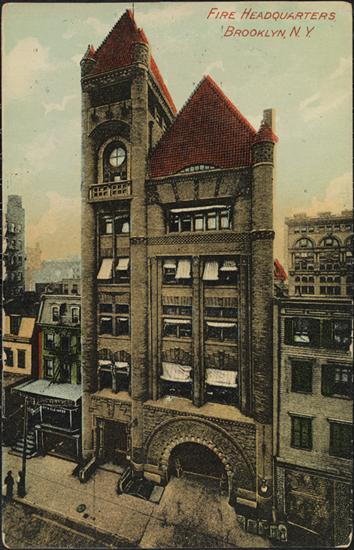
With demolition eminent, the ladder company was forced to move to new headquarters at 365 Jay Street in 1949. This was the original Brooklyn Brooklyn Fire Department Headquarters, a six-story building constructed in 1892.
In December 1853, construction began on the Brooklyn House of Detention for Men at 275 Atlantic Avenue. The 11-story prison could accommodate 817 male prisoners, ages 16-21, awaiting trial or sentencing.
Today, Ladder Company 110 is located with Engine Company 207 in a nondescript fire station at 172 Tillary Street.
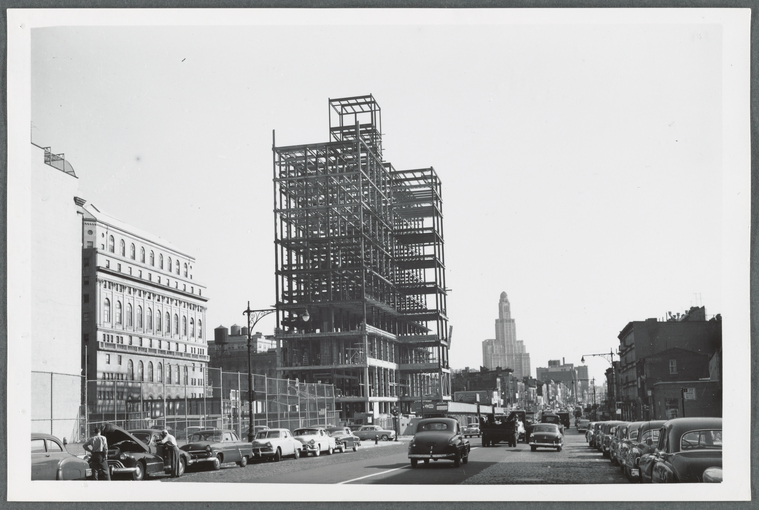
If you enjoyed this fire cat story, you may also like reading about Tootsey, the feline firefighter of Engine Company No. 27 in 1895.




I know exactly where that firehouse is.
What a great story and what a great cat! I’m so glad it seems like Patsey and his animal coworkers at the station lived good, happy lives.